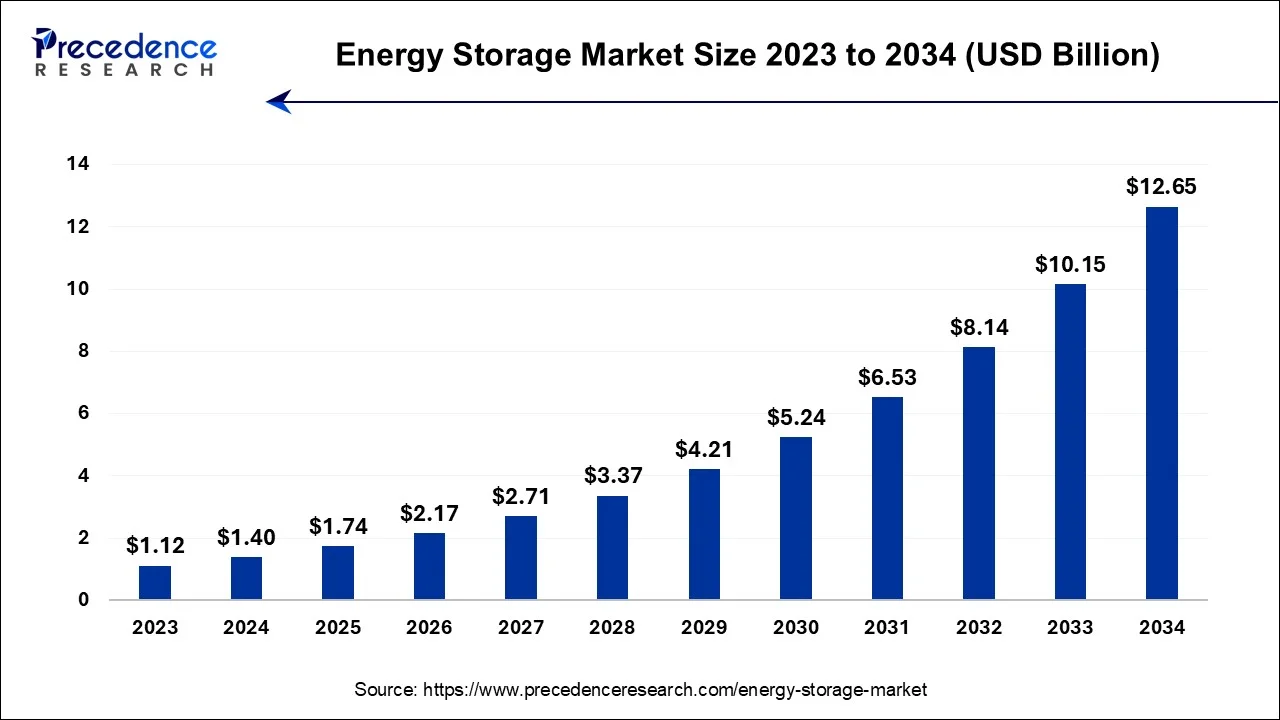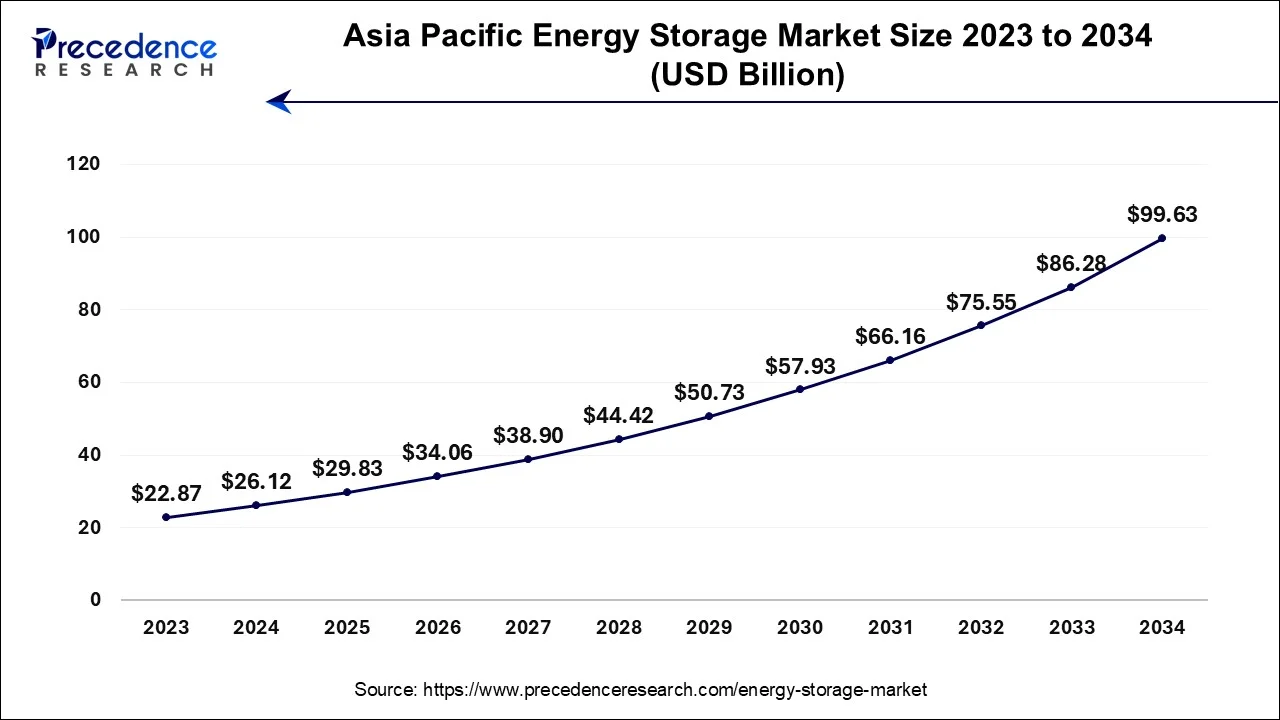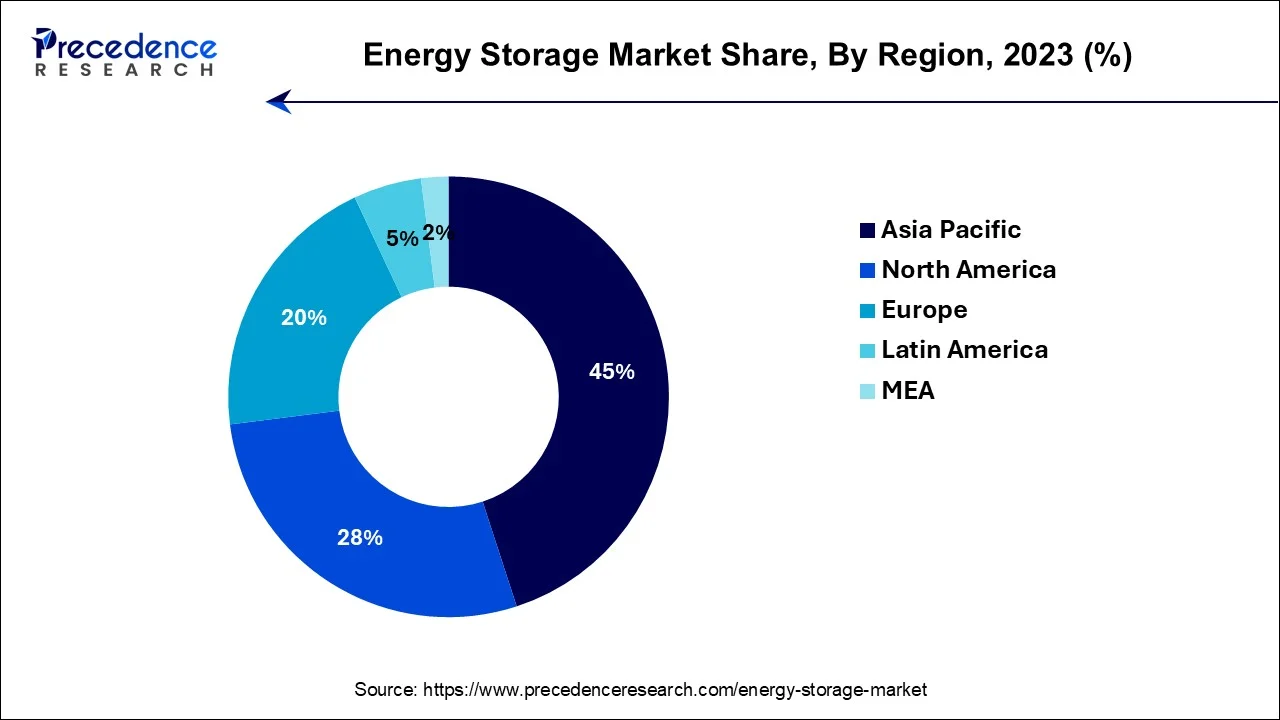January 2025
The global energy storage market size is estimated at USD 1.74 billion in 2025 and is predicted to surpass around USD 12.65 billion by 2034, expanding at a CAGR of 14.20% between 2025 and 2034. The Asia Pacific market size accounted for USD 26.12 billion in 2024 and is expanding at a CAGR of 14.32% during the forecast period. The market sizing and forecasts are revenue-based (USD Million/Billion), with 2024 as the base year.
The global energy storage market size accounted for USD 1.4 billion in 2024 and is anticipated to to reach around USD 12.95 billion by 2034, expanding at a CAGR of 14.20% between 2025 and 2034.

The Asia Pacific energy storage market size is estimated at USD 29.83 billion in 2025 and is expected to be worth around USD 99.63 billion by 2034, registering a CAGR of 14.32% from 2025 to 2034.

Asia Pacific has held the largest revenue share 45% in 2024. The Asia-Pacific region has carved out a prominent niche in the energy storage market due to a convergence of distinctive factors. Primarily, its meteoric economic expansion and urbanization, most notably in countries such as China, Japan, and South Korea, have spurred a heightened appetite for energy, catalyzing the adoption of energy storage solutions. Concurrently, robust governmental initiatives, encompassing financial incentives and ambitious renewable energy integration targets, have propelled the rapid development of energy storage projects. The region's burgeoning electric vehicle market, combined with an ardent drive for grid modernization and energy security, has further stoked the fervor for energy storage technologies, cementing its commanding presence in the market.

North America is estimated to observe the fastest expansion. North America commands a significant share of the energy storage market for various reasons. First, the region has witnessed robust investments in renewable energy projects, requiring energy storage to manage intermittent sources. Additionally, supportive government policies, tax incentives, and a strong regulatory framework have stimulated market growth. North America's growing electric vehicle market has also fueled the demand for advanced energy storage solutions. Moreover, the need for grid stability and resilience in the face of extreme weather events further drives the adoption of energy storage. These factors collectively establish North America as a major player in the energy storage market.
Energy storage encompasses the art of accumulating and safeguarding energy in diverse guises to harness at a later time. It serves as a pivotal element within contemporary energy frameworks, facilitating equilibrium between the availability and necessity of energy. This encompasses conventional methodologies like electric storage via batteries and the ingenious mechanism of pumped hydro storage, where energy is preserved by elevating water to be discharged subsequently. Energy storage proves instrumental in bestowing consistency to renewable energy resources, such as wind and solar, by amassing excess energy when it abounds and disbursing it during periods of heightened demand. This innovation stands as a linchpin for bolstering grid reliability, mitigating energy expenses, and fostering a sustainable energy landscape.
| Report Coverage | Details |
| Market Size by 2034 | USD 12.65 Billion |
| Market Size in 2025 | USD 1.74 Billion |
| Market Size in 2024 | USD 1.4 Billion |
| Growth Rate from 2025 to 2034 | CAGR of 14.20% |
| Largest Market | Asia-Pacific |
| Base Year | 2024 |
| Forecast Period | 2025 to 2034 |
| Segments Covered | Type, Application, and Region |
| Regions Covered | North America, Europe, Asia-Pacific, Latin America, Middle East & Africa |
Grid stability and resilience
The energy storage market experiences a surge in growth driven by the imperatives of grid stability and resilience. In an era of escalating complexity and grid susceptibilities, energy storage stands out as a pivotal solution. Today's grids grapple with a confluence of challenges, including erratic renewable energy supplies, escalating energy demands, and the capriciousness of extreme weather conditions.
Energy storage systems assume a role of paramount significance by adeptly amassing surplus energy during periods of subdued demand and orchestrating its release during surges, effectively counteracting power interruptions and diminishing the vagaries of grid irregularities. Furthermore, grid resilience stands as a powerful motivator. Energy storage engenders an alternative power source during grid upheavals, whether they stem from malevolent cyber intrusions, natural calamities, or equipment malfunctions.
The capacity to respond promptly to disruptions becomes the linchpin for various industries, safeguarding critical infrastructure, and buttressing the preparedness of emergency services. It concurrently curtails the grid's overall susceptibility, bestowing it with a heightened level of robustness in the face of unforeseen challenges. In these roles as facilitator of grid stability and enabler of grid resilience, energy storage ascends as an indispensable cornerstone in contemporary energy systems. This dual attribute garners substantial investments and catalyzes the expansion of the energy storage market, as grid reliability takes center stage in an ever-evolving energy landscape.
Limited energy density
Constrained energy density stands out as a significant constraint impeding the expansion of the energy storage market. Energy storage technologies, particularly batteries, grapple with intrinsic limitations concerning how much energy they can house relative to their physical dimensions and weight. These boundaries imply that for applications demanding substantial energy reserves, like extended-range electric vehicles or large-scale grid storage, the spatial and weight requisites for achieving the necessary energy capacity become burdensome and unfeasible.
Such limitations not only erode the efficiency and efficacy of energy storage solutions but also introduce challenges related to mobility and spatial allocation. Frequently, the necessity for larger installations or heavier batteries amplifies costs and undermines the overall viability of energy storage ventures. Surmounting these constraints mandates advancements in materials science and engineering to cultivate storage solutions characterized by superior energy density, an arena continually explored for innovation within the energy storage realm.
Electric vehicle (EV) market
The burgeoning electric vehicle (EV) market acts as a fulcrum for substantial prospects within the energy storage domain. EVs, hinging on high-capacity batteries for their locomotion, are not only a driving force but also a crucible of technological innovation and scale economies in energy storage. The surging demand for EVs catalyzes extensive research and development, culminating in the emergence of more efficient and cost-efficient battery technologies. These breakthroughs, originally intended for the EV sector, radiate into diverse applications across the energy storage landscape.
Additionally, the proliferation of EV charging infrastructure and the advent of bi-directional vehicle-to-grid (V2G) systems enable an intricate exchange of energy between EVs and the grid. This paves the way for leveraging EV batteries as grid storage reservoirs, buttressing grid reliability, and fortifying the assimilation of renewable energy resources. The EV market, with its transformative influence on battery technology and grid interplay, emerges as a dynamic force propelling the expansion and diversification of the energy storage market.
According to the type, the pumped-storage hydroelectricity (psh) has held a 35% revenue share in 2024. Pumped-storage hydroelectricity (PSH) commands a significant share in the energy storage market due to its unique ability to store and release large amounts of energy swiftly and efficiently. PSH systems use surplus electricity to pump water uphill, storing potential energy, which can be rapidly converted back into electricity when demand surges. This quick response and high energy capacity make PSH ideal for grid stability, especially in managing fluctuations from intermittent renewable sources. Its proven track record, reliability, and ability to support the integration of renewables have solidified PSH as a major player in the energy storage landscape.
The others segment is anticipated to expand at a significant CAGR of 15.2% during the projected period. The others segment in the energy storage market holds a significant share due to its diversity of technologies and applications. It encompasses emerging and specialized energy storage solutions, such as flywheels, compressed air energy storage, and thermal storage. These systems cater to a wide range of unique needs, from short-duration grid stabilization to long-term energy storage for industrial processes. Moreover, as innovation continues, this segment is particularly dynamic, offering versatile and customized solutions for specific use cases, thereby contributing substantially to the overall energy storage market's adaptability and growth.
Based on the application, the commercial and industrial segment is anticipated to hold the largest market share of 56% in 2024. Commercial entities seek to reduce energy costs and enhance energy reliability, while industries aim to manage demand and integrate renewable sources. Energy storage solutions offer grid stability, peak shaving, and backup power during outages, aligning with C&I objectives. Moreover, incentives, including demand charge management and energy arbitrage, drive adoption in this segment. As C&I users increasingly embrace sustainability and self-generation, energy storage plays a pivotal role in meeting these goals, securing its major market share.
On the other hand, the others segment is projected to grow at the fastest rate over the projected period. The residential sector commands a substantial share of the energy storage market for various compelling reasons. One pivotal factor is the growing prevalence of residential solar installations, prompting homeowners to seek energy storage options to capture surplus energy for later use. Moreover, heightened environmental awareness encourages households to reduce their grid dependence and embrace cleaner energy sources. The quest for energy self-sufficiency and the potential for economic advantages further propel residential interest in energy storage solutions. This confluence of motivations establishes the residential segment as a prominent driver in propelling the energy storage market forward.
Future demand for energy storage systems will dramatically increase due to the inevitable growth of renewable sources of energy that are intermittent, like solar and wind. Studies show that demand drivers include the need to manage peak load, ensure grid stability, and the importance of decentralized energy. Additionally, policy drivers and net-zero commitments across major economies support a more permanent long-term increase in market activity and demand, particularly in electric mobility and residential and utility-scale applications.
By Type
By Application
By Geography
For inquiries regarding discounts, bulk purchases, or customization requests, please contact us at sales@precedenceresearch.com
No cookie-cutter, only authentic analysis – take the 1st step to become a Precedence Research client
January 2025
January 2025
January 2025
August 2024